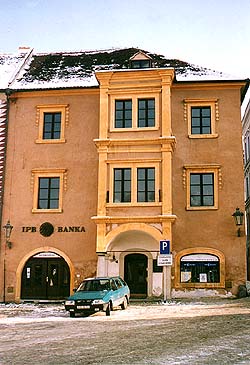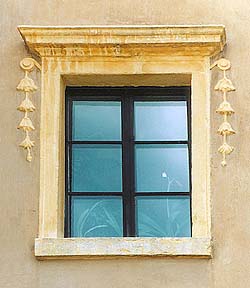Náměstí Svornosti No. 4
 Location:
Location:
Náměstí Svornosti No. 4
Description of the Building:
Approximately in the center of this two-storey, corner building is
a buttressed oriel that protrudes foreward into the square. It is
supported by two Tuscan coulmns, between which is a wide archway.
The front facade of the building is sub-divided by contoured
cornices. Around the windows are stone shams with contoured
cornices aboves these. On the sides of the windows there is
terracotta ornamental work of a Classical plait design. The
interior ground floor is subdivided into two sections, Both of
which are barrel vaulted. The space in the first, and part of the
second floor is of a Renaissance style, but still contains its
original Gothic vaulting. The cellars are vaulted with stone,
barrel vaults.
Architectural and Historical Development:
The building contains its original Gothic core. Radical
reconstruction occurred in the Renaissance period, and around the
years 1510-1520 an extraordinary early Renaissance wall mural of
the Roman satirist Persia was painted on the first floor of the
building. Further redevelopments occurred before the the middle of
the 19th century. Restoration work was last carried out in
1979-80.
Significant Architectural Features:
Fragments of the 16th century wall murals which are documented to
be from the early period of Humanism in Krumlov.
Painting restoration:
During the great restoration of the house in 1979 has been
discovered by exploration of plasters the mural painting on one
wall in room on the second floor. After uncovering was explored
large fragment of the figural tableau and under the ceiling greater
part of painted vegetal festoon with the Rožmbergs´
emblem.
Scene of excited and gesticulating men and women at a balustrade
with skittle shaped parapet in front of the statue of antique
goddess (Venus?) is an illustration of satirical - moralizing
verses written by the Roman poet Aules Persius Flaccus and we can
suppose that such a painting had its continuation on the other
walls of this living room. Painting (although preserved just
fragmentally) shows high artistic value and it is realized by
technique fresco-secco with illusory modulation of shapes. Its full
color recognizes the lasting late Gothic colorfulness, but its
whole character shows, that author was either under influence or
coming from North Italian environment. The topic of Roman poems
comes from early phase of renaissance humanism, which developed in
Český Krumlov thanks to Václav from
Rovné and Petr from
Rožmberk. From the owners of this house, who could order such
an important painting, it had probably been Václav Albín
from Helfenburk, who has held since 1522 several position at
the Rožmberk manor and whose family owned the house even in the
second half of the 16th Century. Paintings have been probably
whitened during restoration in at the end of the 16th Century and
that is why they are so damaged. Detailed evaluation of these
extraordinary paintings is aim of the further studies.
The painting has been preventively covered by stickers, so it can
not be damaged during the restoration works. Later on has been
decided that painting will be transported to the same room on the
first floor, where it becomes a part of a prestige store. That is
why it was took down in 24 pieces. At first the protective stickers
were removed, painting surface cleared, strengthened and belted
with new stickers necessary for painting removal. Separate pieces
were on the back side abraded into the thickness of plaster
necessary for new implantation and on the reverse side were parts
strengthened. In 1980 were the painting inserted into the new
plasters on the first floor. Removed pieces were on the reverse
sides straightened and provided with insole of thin textile by
light strengthened plaster. After setting, the stickers were
removed, surface cleared and damaged areas filled with cement. The
painting had lot of damages and that is why it had to be often
retouched, carried out by lighter local shades for an optical
consolidation of painting.
Above the figures can one read several verses, from which just
two have been defined:
-
On the first and second line from left the quotation from Perseus´s Satires (V 117): "Astutam vapido servas sub pectore vulpem", what means: "IN CORNER OF YOUR PERVERTED HEART YOU KEEP INSIDIOUS FOX".
-
On the right side strongly damaged quotation from Perseus´s Satires (V 53): "Velle suum cuique nec voto vivitur uno", what means: "EVERYONE HAS HIS WISH AND SO WE DO NOT LIVE MONOTONOUSLY".
Defined and translated by dr. J. Hejnic.
Further information:
History
of Painting in Český Krumlov
History
of Painting in the Český Krumlov Region
History of the House Residents:
The first known owner of the building (1424) was Václav Tlačiko. He
was followed by a shoemaker named Linhart. After Mareš Zahradec
were various more significant owners including a goldsmith
Albrecht, from Nové Hrady. Albrecht owned the building from the
beginning of the 16th century and sold it to a butcher named Martin
in 1520. In 1543, the building was obtained by the Rosenberg
chancellor Václav Albín
of Helfenburg. His descendants then traded the building with
Peter
Wok´s secretary, Martin Šurer from Waldenheim, for his building
at Široká
No. 77. Martin Šurer began to renovate his new building but he
did not end up staying here for too long. He was infected with
typhoid fever while on a visit to the castle in Třebon. He suffered
from a high fever and spells of delirium, and one night ran away
from his nurses, jumped into the well between the castle and the
brewery and drowned. Peter Wok then gave the building to the Český
Krumlov magistrate Jan Benýdek from Veveřín and Mysletín who
continued the Renaissance renovation project. In September of 1601
there was a wedding of Benýdek´s son, which was also attended by
Peter Wok.
Present Use:
Melody Voříšek, Municipal Authority, senator office - MuDr. M.
Dvořák


